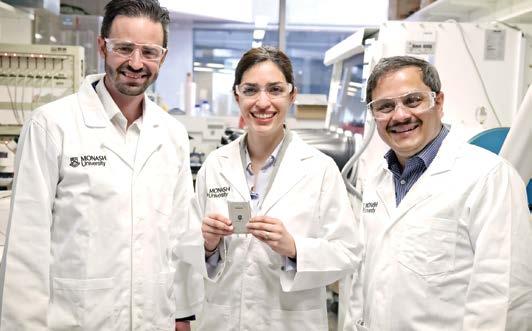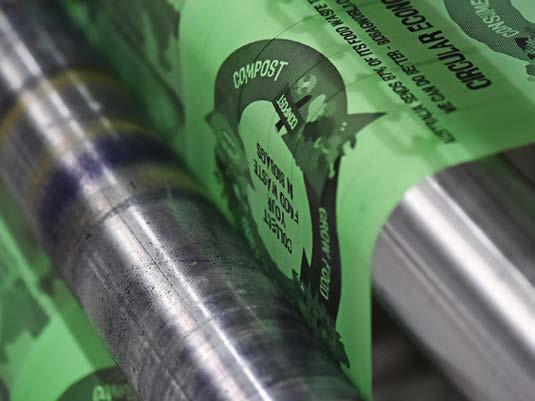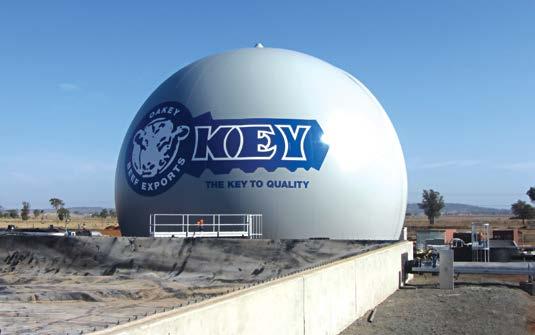
10 minute read
Innovative Solutions
Thermal insulation barrier provides corrosion protection and “cool-to-touch” properties
Industries and facilities around the world face challenges linked to the maintenance of pipework, tanks, and vessels. Damage and deterioration of pipes, valves and fittings are a widespread problem and occur due to corrosion, erosion, thermal cycling, and chemical attack. In order to save energy costs and reduce waste, companies are recognising the importance of insulating their equipment to prevent heat loss and increase efficiency, however, this creates another issue, corrosion under insulation (CUI). CUI is a major issue which occurs on equipment operating in low, ambient, and high-temperature environments.
Advertisement
The role of insulation for heat conservation is crucial, but also shielding personnel from burns when working with hot machinery and equipment is extremely important as metallic surfaces at ≥ 60°C can lead to hot burns when touched.
Moreover, equipment operating in low temperatures and sub-zero conditions can result in ice-build-up, condensation and dripping of water, increasing slipping hazards and provoking ice burns when handled at < 0°C. In this case, it is essential that the insulating material possesses anti-icing properties.
Various solutions are available in the market such as traditional insulation, barriers or guards and water-based coatings. However, individually, they do not hold all the requirements to insulate machinery and equipment whilst also providing corrosion prevention and personnel protection from potential contact burn injuries.
It is for that reason that Belzona has developed an innovative, two-component, polymeric, solvent-free system - Belzona 5871. This multi-functional material provides thermal insulation and corrosion protection, whilst improving safety, efficiency, and durability of the industrial equipment all in a single product.
Belzona 5871 is designed to be applied onto metal pipework, ducting, tank/vessel externals, and other industrial equipment. It is thermally insulating and improves efficiency whilst also preventing contact burn injuries, condensation, and icing. It can be applied by brush, cartridge, or heated airless plural spray which is ideal for small, complex geometries or rapid application over large areas, offering a fast return to service and high film build with potentially just one layer of product.
Upon application, the product forms a lightweight, high-build closed-cell foam. Due to the foaming epoxy technology, Belzona

5871 expands up to three times its applied thickness e.g. 1mm applied gives 3mm cured thickness, thus increasing the amount of product on the surface. Furthermore, Belzona 5871 is a solvent-free corrosion barrier, eliminating the need for any additional primer or top-coats, reducing the number of layers needed compared to conventional coating solutions. Overcoat times are up to 24 hours irrespective of temperature or humidity providing application flexibility. The cure speed and reduced number of layers required, ensure a fast return to service.
To test the thermal barrier properties, comparison between a section of uncovered steel substrate and a section of substrate protected with Belzona 5871 was carried out to determine the thickness required to reduce the surface temperature to below 60°C (140°F) as required by ASTM C1055 to prevent contact burn injuries. For example, Belzona 5871 applied at a thickness of approximately 2.2mm to give a cured thickness of 6.6 mm, will reduce the surface temperature from 120°C (248°F) to below 60°C (140°F). Belzona 5871 is insulating and capable of reducing heat transfer thus providing a safe to touch surface and preventing contact-burn injuries. The insulating properties of Belzona 5871 were confirmed using the Lee’s disc method giving a low thermal conductivity of approximately 0.1 W/m.K.
Several tests have been carried out to confirm the corrosion resistance of the Belzona 5871 system.
CUI conditions have been simulated using heated pipe sections. The system was repeatedly cycled between 120°C (248°F) and 10°C (50°F) over a period of 1000 hours with alternating wet (with a constant deluge of water at 5 litres per minute) and dry periods. Following the test, the multi-layered systems did not show any blistering, delamination, or cracking and there was no evidence of corrosion.

A 35°C (95°F) salt spray test has also been carried out, in accordance with ASTM B117 on a single layer of Belzona 5871 following two different cure regimes; a 20°C (68°F) cure and 120°C (248° F) postcure. A vertical 50mm scribe was added to both samples to encourage corrosion. The test samples did not show any signs of failure even after 3000 hours of continuous exposure.
A continuous water immersion test was performed, in accordance with ISO 2812-2, where a substrate with a single layer of Belzona 5871, was immersed at 40°C (104°F) in deionised water. The substrate did not exhibit any signs of deterioration after 4500 hours (substrate cured at 20°C/68°F) and 2000 hours (substrate post-cured at 120°C / 248°F).
These tests confirm the excellent corrosion resistance properties of Belzona 5871 under a variety of conditions.
The product’s anti-icing and anticondensation properties were independently evaluated by performing an ice build-up test. The sub-zero trial was performed on one, two and three layers of Belzona 5871.
The test confirmed that Belzona 5871 prevents ice build-up and condensation even at sub-zero temperatures.
In conclusion, Belzona 5871 is an innovative solution, providing machinery and equipment with thermal insulation barrier to increase efficiency and durability. In addition, the protection against corrosion and solving problems of CUI extends the service life of equipment, reducing future replacement costs. Belzona 5871 is also a safety-conscious solution, reducing surface temperatures to below 60°C (140°F) to prevent contact-burn injuries.
Belzona 5871 is available in orange and is supplied in two pack sizes: 8 x 0.6 litres and 2 x 7.5 litres. For more information, please visit: www.belzona.com/5871
Monash researchers develop world's most efficient lithium-sulphur battery

Imagine having access to a battery, which has the potential to power your phone for five continuous days, or enable an electric vehicle to drive more than 1000km without needing to “refuel”.
Monash University researchers are on the brink of commercialising the world’s most efficient lithium-sulphur (Li-S) battery, which could outperform current market leaders by more than four times, and power Australia and other global markets well into the future.
Dr Mahdokht Shaibani from Monash University’s Department of Mechanical and Aerospace Engineering led an international research team that developed an ultrahigh capacity Li-S battery that has better performance and less environmental impact than current lithium-ion products.
The researchers have an approved filed patent (PCT/AU 2019/051239) for their manufacturing process, and prototype cells have been successfully fabricated by German R&D partners Fraunhofer Institute for Material and Beam Technology. Some of the world’s largest manufacturers of lithium batteries in China and Europe have expressed interest in upscaling production, with further testing to take place in Australia in early 2020.
The study was published in Science Advances earlier this year – the first research on Li-S batteries to feature in this prestigious international publication.
Professor Mainak Majumder said this development was a breakthrough for Australian industry and could transform the way phones, cars, computers and solar grids are manufactured in the future.
“Successful fabrication and implementation of Li-S batteries in cars and grids will capture a more significant part of the estimated $213 billion value chain of Australian lithium, and will revolutionise the Australian vehicle market and provide all Australians with a cleaner and more reliable energy market,” Professor Majumder said.
Pictured above: Associate Professor Matthew Hill, Dr Mahdokht Shaibani and Professor Mainak Majumder with the lithium-sulphur battery design.
“Our research team has received more than $2.5 million in funding from government and international industry partners to trial this battery technology in cars and grids from this year, which we’re most excited about.”
Using the same materials in standard lithium-ion batteries, researchers reconfigured the design of sulphur cathodes so they could accommodate higher stress loads without a drop in overall capacity or performance.
Inspired by unique bridging architecture first recorded in processing detergent powders in the 1970s, the team engineered a method that created bonds between particles to accommodate stress and deliver a level of stability not seen in any battery to date.
Attractive performance, along with lower manufacturing costs, abundant supply of material, ease of processing and reduced environmental footprint make this new battery design attractive for future real-world applications, according to Associate Professor Matthew Hill.
“This approach not only favours high performance metrics and long cycle life, but is also simple and extremely low-cost to manufacture, using water-based processes, and can lead to significant reductions in environmentally hazardous waste,” Associate Professor Hill said.
The research team comprises: Dr Mahdokht Shaibani, Dr Meysam Sharifzadeh Mirshekarloo, Dr M.C. Dilusha Cooray and Professor Mainak Majumder (Monash University); Dr Ruhani Singh, Dr Christopher Easton, Dr Anthony Hollenkamp (CSIRO) and Associate Professor Matthew Hill (CSIRO and Monash University); Nicolas Eshraghi (University of Liege); Dr Thomas Abendroth, Dr Susanne Dorfler, Dr Holger Althues and Professor Stefan Kaskel (Fraunhofer Institute for Material and Beam Technology).
Compostable cucumber wrap adapts to new industries

by Jessica Bassano
A fully compostable shrink-wrap developed in South Australia for cucumbers is being adopted by other food sectors and a global airline.
The material’s Adelaide-based manufacturer, BioBag World Australia, has doubled production in the past six months and will significantly boost its output again from next month when a second extruder and conversion machine arrives from China.
BioBag World Australia managing director Scott Morton said the company had recently partnered with Qatar Airways, which now used the compostable packaging to reduce waste and collect food scraps.
He said in the past three months the compostable packaging had also been used to replace traditional mailing films covering magazines and newspapers, as well as to wrap meats.
“We have a lot of butchers who have decided to go plastic free. They’re using the film to wrap meat before they freeze it,” Morton said.
“And, instead of giving you a plastic bag when you buy your meat, they’re giving you a compostable bag. That compostable bag can be reused at home to collect your scraps and then it goes into the organics bin where it breaks down.”
The alternative plastic wrapping was initially used last year on cucumbers sold at South Australian independent grocer Drakes Supermarkets.
It was created in partnership with South Australian produce and packaging business IG Fresh Produce and launched in September as an environmentally friendly alternative to the traditional polyethylene plastic wrap.
Morton said while the bulk of the business’ growth was driven by Australia’s agricultural sector, the company had collaborated with a number of international organisations.
“Overall the growth is staggering. You’ve got whole countries now banning plastic produce bags – you can’t buy a plastic shopping bag in France or Italy and you’ve got South Australia looking to ban some plastics,” he said.
“The really exciting thing is that we’re making it here in Adelaide and we’re now able to make almost any product because it’s becoming really mainstream.
“Someone can ring us up with the specifications required and we make that product. It’s business as usual in exactly the same way as if it was a plastic product.”
The Norway-based BioBag produces more than one billion bags a year at six factories around the world, including one in South Australia where the compostable cucumber wrap was developed and is manufactured.
Morton said the arrival of the new machinery from China would not only drastically increase the company’s output but also allow BioBag World Australia to produce more robust compostable wrapping and bags.
“The beauty of that extruder is we’ll be able to make some more advanced products,” he said.
“It means that we can put more advanced materials into the one blend and as a result we can change the properties of the end product.
“For example, we could make a film that has a barrier property to block gas or moisture. It really gets into advanced plastic replacing.”
South Australia has led the nation in recycling and plastic reduction, introducing a container deposit scheme in 1977 and banning single use plastic bags in 2009.
Last year the South Australian Government introduced legislation to ban a range of singleuse plastic products including plastic straws, cutlery and stirrers.












